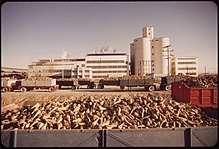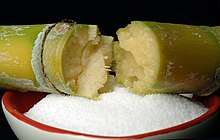Sugar industry
The sugar industry subsumes the production, processing and marketing of sugars (mostly saccharose and fructose). Globally, most sugar is extracted from sugar cane (~80 % predominantly in the tropics) and sugar beet (~ 20%, mostly in temperate climate like in the U.S. or Europe).

Sugar is used for soft drinks, sweetened beverages, convenience foods, fast food, candy, confectionery, baked products, and other sweetened foods. Sugarcane is used in the distillation of rum.
Sugar subsidies have driven market costs for sugar well below the cost of production. As of 2018, 3/4 of world sugar production was not traded on the open market. The global market for sugar and sweeteners was some $77.5 billion in 2012, with sugar comprising an almost 85% share, growing at a compound annual growth rate of 4.6%.[1]
Globally in 2018, around 185 million tons of sugar was produced, led by India with 35.9 million tons, followed by Brazil and Thailand.[2] There are more than 123 sugar-producing countries, but only 30% of the produce is traded on the international market.
Market
Sugar subsidies have driven market costs for sugar well below the cost of production. As of 2018, 3/4 of world sugar production is never traded on the open market. Brazil controls half the global market, paying the most ($2.5 billion per year) in subsidies to its sugar industry.[3]
The US sugar system is complex, using price supports, domestic marketing allotments, and tariff-rate quotas.[4] It directly supports sugar processors rather than farmers growing sugar crops.[4][3] The US government also uses tariffs to keep the US domestic price of sugar 64 to 92% higher than the world market price, costing American consumers $3.7 billion per year.[4] A 2018 policy proposal to eliminate sugar tariffs, called "Zero-for-Zero", is currently (March 2018) before the US Congress.[3][5] Previous reform attempts have failed.[6]
The European Union (EU) is a leading sugar exporter. The Common Agricultural Policy of the EU used to set maximum quotas for production and exports, and a subsidized sugar sales with an EU-guaranteed minimum price.[7][8] Large import tariffs were also used to protect the market.[7] In 2004, the EU was spending €3.30 in subsidies to export €1 worth of sugar, and some sugar processors, like British Sugar, had a 25% profit margin.[9]
A 2004 Oxfam report called EU sugar subsidies "dumping" and said they harm the world's poor.[9] A WTO ruling against the EU quota and subsidy system in 2005-2006[10] forced the EU to cut its minimum price and quotas, and stop doing intervention buying.[7] The EU abolished some quotas in 2015,[11][12], but minimum prices remain.[11][13][14] Tariffs also persist for most countries.[15] In 2009, the EU granted Least Developed Countries (LDCs) zero-tariff access to the EU market[7] as part of the Everything but Arms initiative.[8]
As of 2018, India, Thailand, and Mexico also subsidize sugar.[3]
Glucose syrups produced from wheat and corn (maize) compete with the traditional dry sugar market.
Global players
The top 10 sugar-producing companies based on production in 2010:[16]
| Rank | Company | 2010/11 Output [Mt] | Country |
|---|---|---|---|
| 1. | Südzucker AG | 4.2 | Germany |
| 2. | Cosan SA Industria & Comercio | 4.1 | Brazil |
| 3. | British Sugar Plc | 3.9 | UK |
| 4. | Tereos Internacional SA | 3.6 | France |
| 5. | Mitr Phol Sugar Corp. | 2.7 | Thailand |
| 6. | Nordzucker Gmbh & Co KG | 2.5 | Germany |
| 7. | Louis Dreyfus | 1.8 | Netherlands |
| 8. | Wilmar International Ltd. | 1.5 | Singapore |
| 9. | Thai Roong Ruang Sugar Group | 1.5 | Thailand |
| 10. | Turkiye Seker Fabrikalari | 1.34 | Turkey |
The global sugar industry has a low market share concentration. The top four sugar producers account for less than 20.0% of the market.[17]
Products
- raw sugar
- liquid sugar
- refined sugar
- molasses
- sugar alcohol
- brown sugar
- Powdered sugar
Lobbying and marketing
The sugar industry engages in sugar marketing and lobbying, minimizing the health effects of sugar and influencing medical research and public health recommendations.[18][19][20][21]
References
- "Global Sugar, Sweeteners Market to Hit $97 Billion by 2017". Natural Products Insider. April 18, 2013.
- "Sugar: World Markets and Trade" (PDF). Foreign Agricultural Service, US Department of Agriculture. 20 November 2018. Retrieved 24 March 2019.
- https://www.washingtontimes.com/news/2018/mar/16/steel-sugar-subsidies-hinder-free-trade/
- "Sugar and sweeteners: Policy". US Department of Agriculture. 20 August 2019. Retrieved 22 November 2019.
- https://yoho.house.gov/media-center/in-the-news/yoho-zero-for-zero-sugar-policy-is-a-trade-win-win-for-everyone
- https://www.cato.org/publications/commentary/why-congress-should-repeal-sugar-subsidy
- http://news.bbc.co.uk/2/hi/business/4118448.stm
- https://ec.europa.eu/agriculture/sites/agriculture/files/sugar/doc/sugar-faq_en.pdf
- https://www.oxfam.org/sites/www.oxfam.org/files/bp61_sugar_dumping_0.pdf
- https://www.ictsd.org/bridges-news/biores/news/brazil-claims-victory-after-wto-ruling-on-eu-sugar-subsidies
- https://ec.europa.eu/agriculture/sugar_en
- https://ec.europa.eu/jrc/en/publication/eur-scientific-and-technical-research-reports/eu-sugar-policy-sweet-transition-after-2015?search
- https://www.tralac.org/discussions/article/5684-the-end-of-the-eu-sugar-quota-and-the-implication-for-african-producers.html
- https://www.theguardian.com/business/2017/mar/27/brexit-sugar-beet-cane-tate-lyle-british-sugar
- https://www.theguardian.com/business/2017/mar/27/brexit-sugar-beet-cane-tate-lyle-british-sugar
- Chanyaporn Chanjaroen (November 4, 2011). "Suedzucker Leads the Top 10 Sugar-Producing Companies". Bloomberg.com.
- "Global Sugar Manufacturing: Market Research Report". IBISWorld. 2016.
- Sifferlin, Alexandra (10 October 2016). "Soda Companies Fund 96 Health Groups In the U.S." Time. Retrieved 2018-03-24.
- Mozaffarian, Dariush (2 May 2017). "Conflict of Interest and the Role of the Food Industry in Nutrition Research". JAMA. 317 (17): 1755–1756. doi:10.1001/jama.2017.3456. ISSN 0098-7484. PMID 28464165.
- Schillinger, Dean; Tran, Jessica; Mangurian, Christina; Kearns, Cristin (20 December 2016). "Do Sugar-Sweetened Beverages Cause Obesity and Diabetes? Industry and the Manufacture of Scientific Controversy" (PDF). Annals of Internal Medicine. 165 (12): 895–897. doi:10.7326/L16-0534. ISSN 0003-4819. PMID 27802504. Retrieved 2018-03-21.(original url, paywalled: Author's conflict of interest disclosure forms)
- O’Connor, Anahad (31 October 2016). "Studies Linked to Soda Industry Mask Health Risks". The New York Times. ISSN 0362-4331. Retrieved 2018-03-23.
See also
- Criticisms of the sugar industry
- Food industry
- All pages with titles containing sugar production
- Category:Sugar industry
Further reading
- Matthew Parker (2012). The sugar barons. Windmill Books. ISBN 978-0099558453.
- Mosen Asadi (2006). Beet-Sugar Handbook. John Wiley & Sons. ISBN 978-0471763475.
- Michael Moss (2014). Salt, Sugar, Fat: How the Food Giants Hooked Us. WH Allen. ISBN 978-0753541470.
